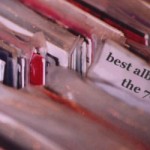Pet Grief: What’s the best audio format?

Last year, Neil Young introduced a new product that promised to be a game changer for music fidelity. An ultra-high resolution audio player shaped like a Toblerone, Pono promises the ability to listen to music at 192 Hz or a 24-bit sampling rate, as opposed to CD quality, which is 16-bit, or 44 Hz. The product launched via Kickstarter last year, raising more than $6 million, and can now be purchased for $400, with long-available albums in the Pono music store going for around $20 for a high-resolution digital version.
It sounds pretty impressive, and those are some pretty big numbers to be throwing around — especially the price tags! — but while the limitations of sound quality might be disappearing, there’s still one thing standing in the way of Pono breaking new ground for listeners: Human biology. In an article for Yahoo, David Pogue cites two studies that conclude that 24-bit sound isn’t even really detectable, noting “the human ear can’t even detect audio quality beyond what’s on a CD.” So, while hypothetically Pono might be the best player in terms of the raw data, it doesn’t really mean much, because that sweet Pono sound is getting cockblocked by our earholes.
This leaves listeners with a strange predicament: In an age of diminishing CD sales, music piracy, Spotify subscriptions we don’t want to pay for, and Reddit trolls telling us that everything we love is wrong and we deserve to be punished for it — what is really the best audio format?
Let’s take a look at our options. First, there are CDs, which are still being sold and bought, and have the highest quality sound our ears can discern, and sometimes you can have them delivered with pizzas. Not a bad option, but they’re growing increasingly more disposable. And as digital files have become the predominant mode of consumption for most listeners — and the most convenient — audio quality aside, CDs are flirting with obsolescence.
Then there’s digital formats. MP3s are notoriously problematic, sometimes having been ripped at a poor quality bitrate, and often featuring unwanted noises as a result of problems with the files. But they’re easy, cheap and you can fit a whole bunch of them on the iPod that Apple just discontinued (not annoyed by that at all, nope). Alternately, you can go for the higher quality FLAC files, which take up more space on your hard drive and cost a little more. But let’s be honest, you’re just downloading Phish bootlegs and Thom Yorke demos, so that’s really not a factor here.
Another option is streaming services like Spotify. There’s some stuff to be said about artist compensation, I guess, but I’ll have to return to this one later, after this round of commercials is over… oh, wait, no there’s another one.
Lastly, we have vinyl. Because it’s not a digital medium, it simply cannot contain as much information as a CD does. On the other hand, even a CD potentially has more information than a human can reasonably hear, which seems to make Pono even more unnecessary. There are some imperfections inherent to vinyl, like surface noise, slight distortions in the dynamic range, etc. There are also some shady labels that basically sell bootleg versions of your favorite records, and do a lousy job of pressing them. That being said, when great care is taken into the pressing and mastering of a vinyl LP, it can be a fabulous listen. Just make sure not to pick up a bright shiny new classic rock album that looks like the sleeve was printed on a Kinkos photocopier.
It’s hard to say which of these format is absolutely the best, but it occurred to me that it’s entirely dependent upon who you’re listening to. So, I picked 10 artists of note to do a listening test in order to determine the best way to hear the music that you deserve to experience properly. Here we go:
Taylor Swift: Well, it sure ain’t Spotify. Taylor Swift has the benefit of the best-paid producers and studios at her disposal, so why not take advantage of the benefits of the format and go ahead and listen to the CD. You can even pick it up at Starbucks!
Kanye West: Few artists — other than Kendrick Lamar — have embraced the album format as Kanye West has done in the last decade. But he also has a lot of standalone tracks in his catalog. Certainly, you’d be expected to listen to the full sequence of My Beautiful Dark Twisted Fantasy in order, but nobody respects artistry anymore, so clearly that’s out the window. So go digital and put it on shuffle. Prreferably FLAC or a high-quality MP3 (320); you really want to make sure you can hear the opulence.
Beyonce: #Flawless in any format. (She woke up like this!)
Ty Segall: With the recent release of the Mr. Face EP, Ty Segall has pioneered the very first double-seven-inch single that can be used as 3-D glasses. And that’s pretty cool, but when you’re dealing with punk or garage rock, it’s best to get a bit more gritty and raw. There’s only one option: Cassette.
Led Zeppelin/Pink Floyd: Both of these bands went through some pretty elaborate reissue and remaster campaigns to offer their catalogs in the most pristine quality possible. And I applaud the effort, but let’s be real here. You should be listening to Zep or Floyd on 8-track. Preferably if the player is installed in the dashboard of a custom van. And a hotboxed custom van will probably enhance the sound further; consult a sound engineer on that last point if necessary.
Mumford & Sons: Just go downtown and listen to some buskers on a streetcorner.
Foo Fighters: In every format, simultaneously, in eight different cities, while hanging out with Bob Mould and Cheap Trick. Borrow Dave Grohl’s ears if necessary.
Jack White: Nobody is doing more in this day and age for format innovations than Jack White, who releases and presses his own vinyl like rock ‘n’ roll’s guacamole-eating Willy Wonka. To get the full experience, I recommend checking out his new four-dimensional hologram vinyl that can only be played on the moon. It’s some next level shit.
Death Grips: The best way to experience Death Grips is to just have Stefan Burnett scream directly in your face. It’s the pure distillation of their essence, really.
Neil Young: You’re expecting me to say Pono, but that’s not happening. As much as I want to give Neil Young credit for developing a new digital format, I’ve found that the best way to hear him is on the format he so strongly adhered to for so long: Vinyl.
You might also like:



Jeff Terich is the founder and editor of Treble. He's been writing about music for 20 years and has been published at American Songwriter, Bandcamp Daily, Reverb, Spin, Stereogum, uDiscoverMusic, VinylMePlease and some others that he's forgetting right now. He's still not tired of it.


Fascinating subject…it brings sound studies scholar/writer Jonathan Sterne’s recurring question to my mind, “fidelity to what?”. That is, to just what are our hi-fidelity/lo-fidelity, etc. recording being loyal? Copies vs. original, and so on and so on. Thanks for posting!